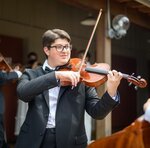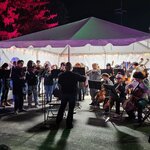One of Cranston’s own will be crossing hemispheres this summer as a viola player in one of the country’s most prestigious youth orchestras.
Liam DeRosa, a junior at Cranston East and …
This item is available in full to subscribers.
We have recently launched a new and improved website. To continue reading, you will need to either log into your subscriber account, or purchase a new subscription.
If you are a current print subscriber, you can set up a free website account by clicking here.
Otherwise, click here to view your options for subscribing.
Please log in to continue |
|


One of Cranston’s own will be crossing hemispheres this summer as a viola player in one of the country’s most prestigious youth orchestras.
Liam DeRosa, a junior at Cranston East and an accomplished violist, has been accepted into Carnegie Hall’s 2024 National Youth Orchestra of the United States of America, the only Rhode Islander to be accepted this year. With his instructors, DeRosa began preparing for the audition last fall.
“I've been learning the excerpts and doing all of the pieces pretty much since the beginning of the school year,” he said. “And I actually tried twice before this and didn't get the offer both times. So I've done this about three times and this is the first time that has been successful.”
The National Youth Orchestra brings together 103 outstanding young musicians, ages 16-19 from across the country. During a two-week intensive residency at the State University of New York at Purchase, they will work with accomplished conductors and musicians to learn and perform three challenging pieces, Samuel Barber’s Symphony No. 1, George Gershwin’s Rhapsody in Blue, and Nikolai Rimsky-Korsakov’s Scheherazade.
Following the intensive, the musicians will perform at Carnegie Hall as part of World Orchestra Week alongside the National Children’s Symphony of Venezuela, the Africa United Youth Orchestra, the Beijing Youth Symphony Orchestra, the European Union Youth Orchestra, and the Afghan Youth Orchestra.
Afterwards, the ensemble will be hopping across the Gulf of Mexico to perform across South America in Montevideo, Uruguay; Rio de Janeiro and São Paulo in Brazil; and Buenos Aires, Argentina.
Admission into the ensemble requires skill, seriousness of intent, and a keen understanding of music, all of which one hears in DeRosa when he speaks. During an interview with the Herald, he gave a description of the piece with which he auditioned for the National Youth Orchestra, Paul Hindemith’s 1935 concerto for Viola and Orchestra “Der Schwanendreher.”
“Hindemith. There are some problems with him,” DeRosa said. “For vocalists especially, he wrote some stuff that was not so good, kind of atonal. And this piece kind of is too. He doesn’t mark a key signature other than C major, but it's not really in C major, because he goes around the circle of fifths quite a bit. There are also a lot of dissonances, such as fourths, sevenths, that don't sound very pleasing to the ear, which is why people find his music in this piece hard to like.”
However DeRosa described his own infatuation with the challenging piece due to its allusions to German folk music.
“The solo viola never actually gets to play the folk song,” he said. “It's all done by the orchestra, and the viola gets some other stuff that Hindemith just wrote.”
He continued “The second movement is a slow movement. It's about the linden tree, and if people were having a bad day, they would go pick leaves off the linden tree. So it's a very beautiful, slow, calming kind of thing. And there's also a second part of that movement, which is the cuckoo sat on the fence. I don't know a lot about that song, but it’s a fugue on that folk song. So he alludes, kind of more to the Baroque, medieval-y kind of aspects to the piece and then we eventually go back to the linden tree theme.”
He went on to describe the final movement of the piece, and said “It's also impossible to play.”
His teachers, who were also present at this interview, protested that DeRosa managed to play it.
DeRosa began his musical journey at the age of six, with piano lessons. The next year, he picked up the violin. And then:
“When I was ten, I played the viola for the first time and just fell in love with it.”
DeRosa says he generally practices at least two to three hours per day, every day. He is part of Cranston East’s orchestra program, ensembles with the Rhode Island Philharmonic, and plays as a freelance performer for events and musical theater productions. He has also participated in the Tanglewood Youth Symphony with Boston University. With the addition of the Carnegie Hall National Youth Orchestra, his schedule will expand still further.
“I think my weekly practice hours, cumulative, will actually raise over the summer through that, like 50 hours a week,” he says.
DeRosa attributes his success in no small part to mentors here in Cranston, and across Rhode Island.
“I've obviously had some really great musical development here at Cranston as with these wonderful teachers and the wonderful students who are here and making this musical community to give me a place to play,” he said. “Also to the Rhode Island Philharmonic Music School for really developing the musician that I am today. I don't think I would be who I am without them and without their support. And, above all, my private teacher at Boston University, Michelle LaCourse, who really helps me with these excerpts a lot and drilling these into me so that I can set myself apart from the other auditioners.”
Here in Cranston, DeRosa is one of hundreds of kids of all skill levels participating in the district’s music programs. Cranston East’s orchestra program includes one string orchestra, one chamber orchestra, and a guitar ensemble. The school also has a choir, a band and a percussion ensemble. Additionally, the career and tech programs at the high school include a music tech track, which focuses on production and audio engineering rather than performance. Students from anywhere in the state can transfer into that CTE program.
Emily Johnson, Program Supervisor of Music for Cranston Public Schools, spoke about how meaningful it can be to have students of all different skill levels working together to create music.
“It's a wonderful thing where you have a student who is going to be playing in a national orchestra, and then we have a kid who over the summer (says) my sister plays violin, I want to play violin too,” she said.
“And we have this mix of kids who still get to be a part of that same kind of community and same group in spite of the differences in their level of technique. They still get to be together, And that's kind of what public school music education it's about, at least on my end, is we welcome everybody and we take you where you are and we do our best to get you from where you are, to where you want to be.”
For DeRosa, following the summer spent with the youth orchestra, his practice time will shift to a new priority: college auditions.
“I'm going to pursue music performance, viola performance in particular, at a conservatory,”
he said. “This year I've been going and doing visits and taking trial lessons with teachers and visiting their studio classes at the school to get a sense of what I like and what I don't like. And then next year, I will have an idea of what schools I want to apply to, so I will apply, do my pre-screenings, see what lab auditions I get as offers, and then hopefully by next spring, I'll have a decision of where I'll actually be.”
The Carnegie Hall National Youth Orchestra will be performing at Carnegie Hall in Manhattan on August 5 as part of World Orchestra Week. Cranston High School East will next be performing with the East Choir at the East auditorium on May 22.
Comments
No comments on this item Please log in to comment by clicking here